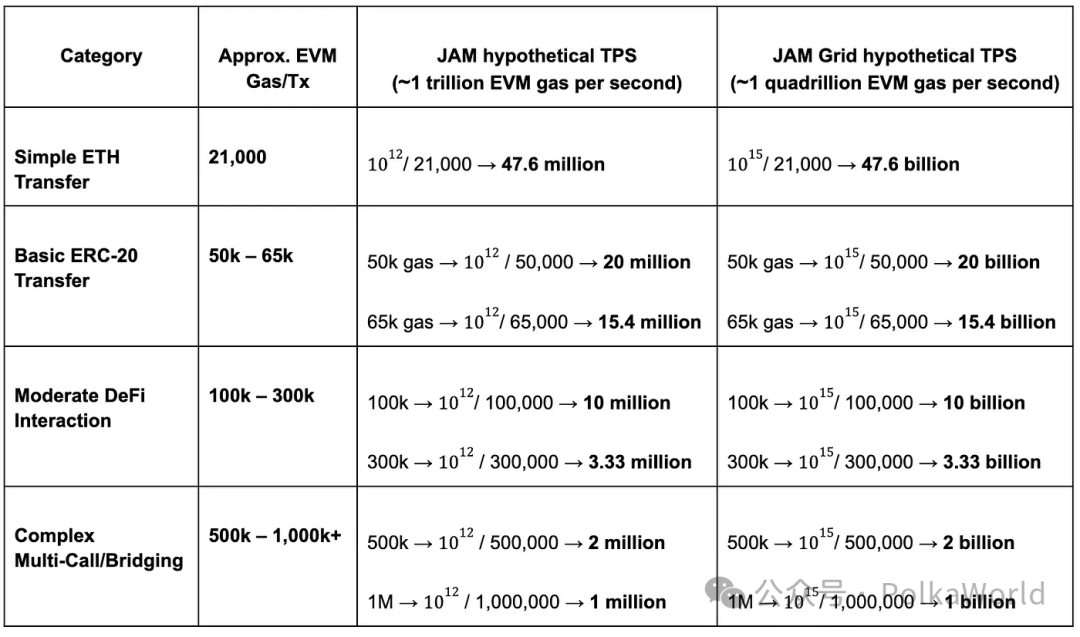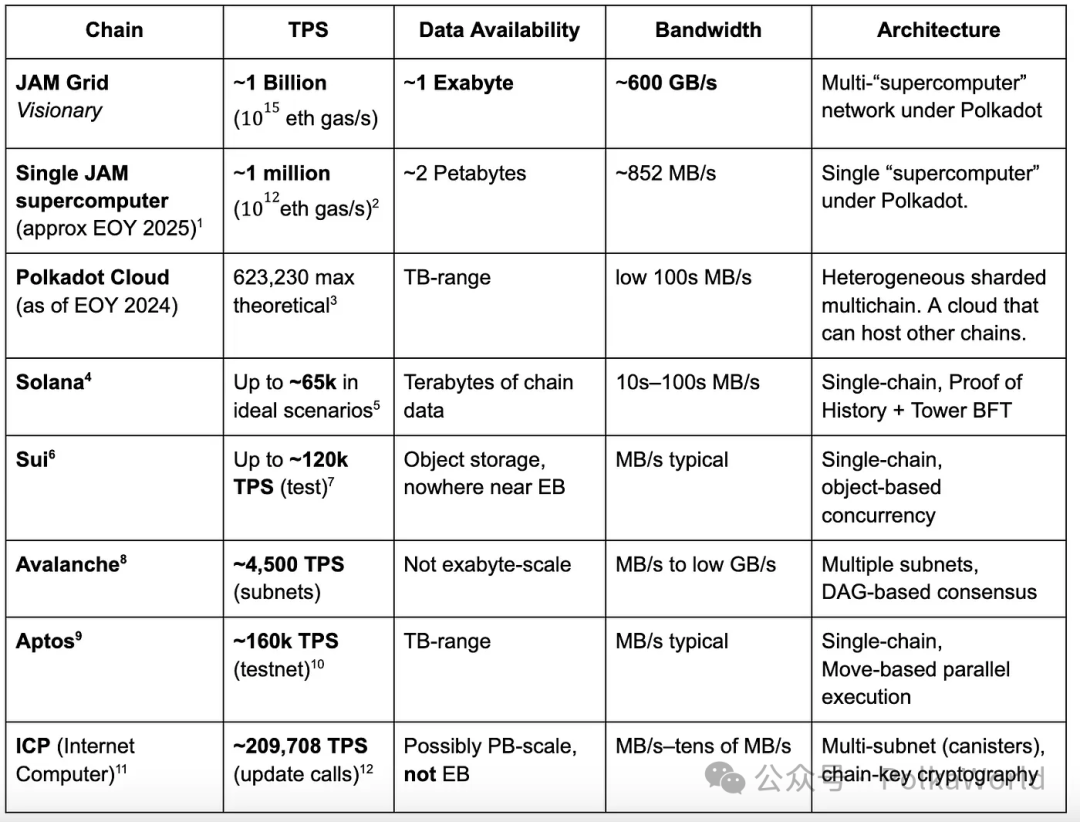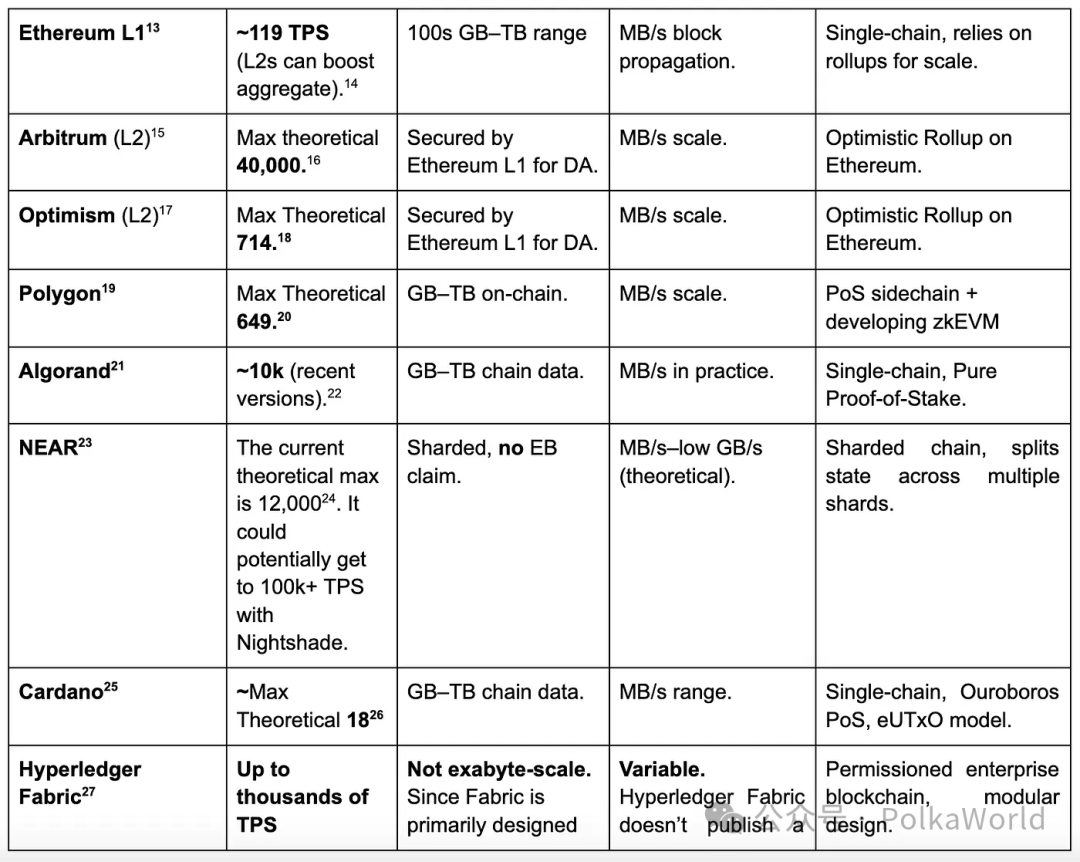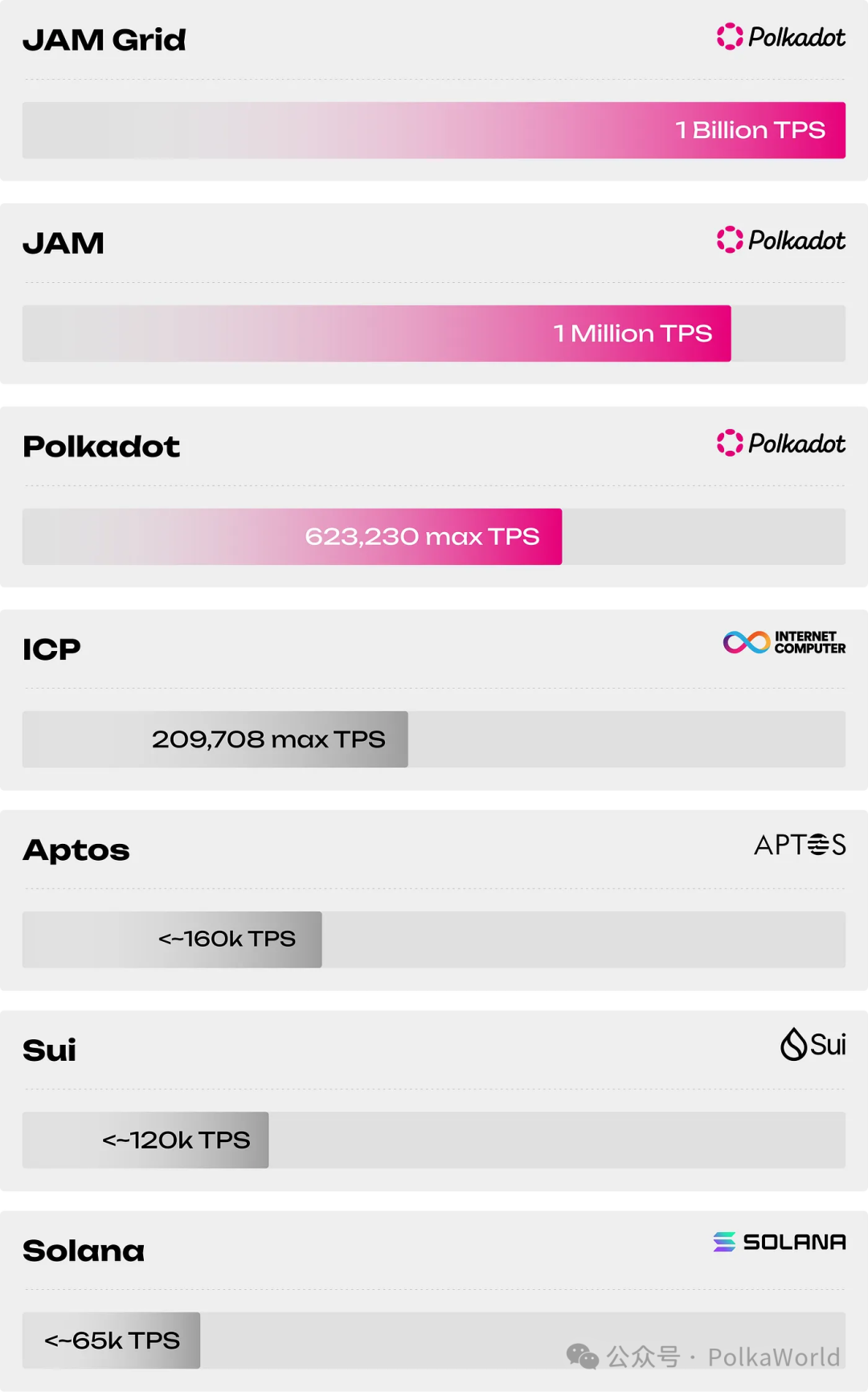Jam and Jam Grid: Polkadot's Web3 Cloud Computing New Age

Reprinted from panewslab
01/26/2025·3M
Original text: Permanence DAO , PolkaWorld
Polkadot aims to be a true Web3 cloud (Polkadot Cloud) , providing the infrastructure for building highly scalable and extremely reliable Web3 applications and services. Although different, this is similar to what AWS does for Web2 applications and services.
Want to learn how JAM and JAM Grid drive Polkadot into a true Web3 cloud ? Check out this article to learn what JAM and JAM Grid are!
-
JAM: Unprecedented scale and computing power
-
JAM Grid: Unlock 1 billion TPS
-
Comparison chart with other blockchains
-
What applications can JAM enable?
-
What applications can be achieved with JAM Grid?
-
How JAM Grid empowers developers
-
How DOT promotes JAM Grid
-
Conclusion
In addition, Dr. Gavin Wood will hold a JAM Tour in 6 cities in China from the end of February to the beginning of March. He will share with everyone at local university centers what JAM is, what problems JAM solves, and what developers can do based on JAM. ! You will have the opportunity to meet Gavin Wood in person and discuss the most cutting-edge technologies and concepts of Web3! Sign up now! "JAM Tour China Station Registration Opens!" 2025 Meet Dr. Gavin Wood! 》
Before we get started, let’s take a look at a brief timeline of the Polkadot Cloud:
Polkadot Cloud — Genesis Phase: May 2020
Polkadot went online at this time and produced the first block, marking the official "go online" of the Polkadot cloud.
Polkadot Cloud — First Milestone (Parachain), November 2021
This is the birth of Polkadot Cloud’s first cloud service. This service allows developers to build custom blockchains and connect them to the Polkadot cloud for shared security.
First cloud service deployment—second milestone, December 2021
The first cloud service (parachain) came online and different teams started using it to deploy their parachains.
Polkadot Cloud — Third milestone (JAM), to be determined, perhaps before the end of 2025
JAM (Join-Accumulate Machine) is a trustless supercomputer that forms the basis of the Web3 cloud.
Polkadot Cloud — Potential Fourth Milestone (JAM Grid), TBD
The JAM Grid will be a hypothetical cluster of interconnected supercomputers, each running the JAM protocol.
Today’s blockchains, even so-called “high-performance” blockchains, struggle to cope with real-time, data-intensive workloads. In contrast, JAM Grid can theoretically achieve one billion transactions per second (TPS), exabyte-scale storage (exabyte-scale storage) and hundreds of GB/s of bandwidth , which may provide Web3 services with the same Capabilities comparable to modern cloud data centers.
Introduction to JAM and JAM Grid
JAM is a single supercomputer that enables people to build scalable and reliable Web3 applications and services. The main goal of JAM is to provide a flexible and efficient framework for managing data and computation in a network. It is designed to simplify data integration and maintenance while ensuring network integrity and security. You can learn more about JAM through Gavin Wood's Gray Paper (https://graypaper.com/) or PolkaWorld's articles.
-
Gavin Wood: JAM is a trustless supercomputer that forms the basis of the Web3 cloud!
-
Heavy! Gavin announces JAM service roadmap! JAM Asia lecture tour will start next year!
-
Registration for JAM Tour China is open! 2025 Meet Dr. Gavin Wood!

A new concept, JAM Grid , proposes the next leap forward: a network of multiple supercomputers that can theoretically achieve billions of transactions per second (TPS), exabyte-level data availability, and high-performance computing ( HPC) level bandwidth.
Regarding the TPS indicator, it is worth noting that in Gavin Wood's year-end summary article , he mentioned that the computing power may reach one quadrillion EVM equivalent gases per second. Since the amount of gas consumed by different transactions varies greatly, there is no universally applicable "transactions per second" (TPS) metric. For example, on Ethereum, a simple ETH transfer may require 21,000 gas, while more complex smart contract interactions may require hundreds of thousands or even millions of gas. Below is a comparison table (note that these figures are approximate).

The above figure shows that for transactions that consume a lot of gas, the upper limit of JAM is about 1 million TPS, and the upper limit of JAM Grid is about 1 billion TPS . However, it's important to note that these figures are approximate.
JAM: Unprecedented scale and computing power
What is JAM?
JAM (Join-Accumulate Machine) is a trustless supercomputer that forms the basis of the Web3 cloud. It is a new computing model and protocol designed to enhance the capabilities of Polkadot and solve scalability challenges in blockchain technology. JAM will support 1 million transactions per second (TPS), 2 petabytes of data availability, and 857 MB/s bandwidth.
Why is it important?
JAM is the next upgrade that will bring Polkadot closer to its original vision of becoming a permissionless global supercomputer .
How do other blockchains compare?
JAM’s scalability is designed to support large-scale real-time applications that traditional blockchains cannot handle.
JAM Grid: Unlock 1 billion TPS
What is JAM Grid?
The JAM Grid is a hypothetical cluster of interconnected supercomputers , each running the JAM protocol, promising 1 billion transactions per second (TPS), 1 exabyte of data storage, and 600 GB/s bandwidth.
Why is it important?
These numbers are well beyond today’s blockchain standards and portend a high-performance computing (HPC)-like scale. If implemented, it would be able to handle global-scale applications while maintaining decentralized security.
How do other blockchains compare?
Projects like Solana, Aptos, Sui, and Avalanche push for higher throughput than traditional blockchains, but still fall short of exabyte-level storage or high-performance computing (HPC)-level bandwidth.
Comparison chart with other blockchains
-
TPS (transactions per second) : A measure of raw throughput – how many transactions per second the blockchain can process. Higher TPS generally means more scalable decentralized applications (dApps) and a better user experience.
-
Data availability : The ability of a blockchain network to store and manage data on-chain. It includes the total amount of data and its accessibility across all network nodes. Strong data availability ensures consistent access and verification of transaction records, application state, and user data while maintaining the integrity, security, and decentralization of the blockchain.
-
Bandwidth : Reflects network capacity—the speed at which data can be transferred through the system. For blockchains designed to handle large volumes of transactions (and associated data), high bandwidth is key to preventing bottlenecks.
-
Architecture : Highlight design approaches—for example, the difference between a single chain versus a sharded or subnet architecture. Architecture affects TPS and how easy it is for the blockchain to scale and evolve.
Now that we understand why these metrics matter, let's see how JAM Grid's vision compares to other leading projects.
It 's important to note that many TPS numbers are testnet or theoretical maximums - actual performance may vary. Metrics for data availability and bandwidth are also ranges/approximations as there are no precise numbers. We try our best to present a fair and accurate comparison, but if you notice an inconsistency, please contact us for a correction.


You can find a Google Doc with diagrams and footnotes here .
Again, the indicators in the chart above are ranges/approximations. If you have more accurate figures, please feel free to contact us.
Key takeaways
-
Exabyte Storage and HPC Bandwidth : JAM Grid envisions delivering 1 exabyte of data storage and 600 GB/s throughput—comparable to a large data center, not a typical blockchain.
-
Comparison to current networks : While blockchains like Solana, Avalanche, and Aptos outperform older platforms in TPS, they cannot come close to HPC-level data availability or sustained bandwidth.
-
Multiple "supercomputer" model : There will be multiple supercomputers, each running the JAM protocol. This would create a network where all supercomputers can communicate with each other and potentially share resources. How these supercomputers communicate with each other will be a key challenge.


What applications can JAM enable?
With approximately 1 million TPS, 2 petabytes of data availability, and 857 MB/s of bandwidth, the JAM supercomputer delivers a quantum leap beyond most existing blockchains. Here are some examples of apps that JAM can unlock:
Real-time games and virtual worlds (city level or country level)
Why not now ? Current blockchains cannot handle frequent game state changes from thousands (let alone millions) of players.
How can JAM help? 1 million TPS means that fast interactions in city- or country-level virtual worlds can be kept on-chain, reducing reliance on centralized servers.
Real-time IoT and Automation (Enterprise or City Level)
Why not now? IoT devices generate millions of events per second in urban or industrial deployments. Most blockchains cannot handle so many on-chain events, easily causing severe congestion.
How can JAM help? A throughput of approximately 1 million TPS coupled with petabyte-level data availability means each device can reliably publish millions of events per second on-chain, making it ideal for large enterprises or smart cities. Hundreds of MB/s of bandwidth ensure rapid synchronization of sensor data between nodes around the world—enough to meet city or enterprise-level needs, but not enough to cover the entire planet's IoT devices.
High traffic stablecoin or payment system (national level)
Why not now? Traditional blockchains face network congestion and high fees under heavy load, limiting the mainstream application of on-chain micropayments.
Can JAM deliver? A capacity of approximately 1 million TPS (assuming simple transactions) allows stablecoins or payment networks to serve national or regional economies. Fast throughput keeps fees low and transactions confirmed quickly. While it won’t enable billions of micropayments per day on a global scale, it will be enough to surpass most existing L1 limitations.
After implementing JAM, Polkadot Cloud will greatly exceed many existing L1s in terms of throughput, storage, and bandwidth, and can support real-time, data-intensive dApps that are not possible on current blockchains.
What applications can be achieved with JAM Grid?
Today’s blockchains — even the “fast” ones — struggle to handle real-time, data-heavy workloads. In contrast, JAM Grid, which supports billions of TPS, exabytes of storage, and hundreds of GB/s of bandwidth, can deliver modern cloud data center-level performance for Web3 services. Here are some examples of applications that may ultimately become a reality under these conditions:
Massively multiplayer virtual worlds and games
Why not now? Current blockchains cannot handle real-time updates from millions of concurrent players, let alone store massive amounts of game assets, status, and logs on-chain.
How can JAM Grid help? With billions of TPS and massive bandwidth, JAM Grid can handle frequent state updates (such as player actions, world changes), with all data kept on-chain, eliminating dependence on centralized game servers. Exabyte-scale storage allows vast libraries of 3D assets, character backpacks, and item histories to remain verifiable and durable.
Real-time IoT and Automation
Why not now? IoT devices continuously generate streams of data—such as temperature, vehicle telemetry, sensor updates—potentially producing millions of events per second. No mainstream blockchain can process and verify such huge amounts of data in near real-time.
How can JAM Grid help? High throughput and scalable data availability allow each device to log updates directly on-chain without overwhelming the network. High bandwidth ensures that data can travel quickly among globally distributed nodes.
Global scale social network
Why not now? Social platforms generate billions of interactions (such as likes, posts, comments, messages) every day, which requires huge throughput and storage. Existing blockchains cannot handle such a massive amount of on-chain activity.
How can JAM Grid help? Billions of TPS can support near-instant publishing, while exabyte-scale storage can preserve rich media and user history without relying on off-chain solutions. Built-in decentralization ensures that no single company controls user data or content moderation.
Decentralized AI and large-scale machine learning
Why not now? Training and inference of large AI models requires massive computing power and huge data sets, which are often handled by centralized high-performance computing (HPC) clusters.
How can JAM Grid help? JAM Grid's HPC-like throughput and bandwidth can host distributed AI workloads on the chain, ensuring the auditability of data, the verifiability of training results, and providing equal access to HPC resources for everyone.
Global Stablecoin Payment System
Why not now? Traditional stablecoins already face congestion and high fees issues under high load on L1 blockchains. Billions of daily micropayments, such as IoT microtransactions and daily purchases, become unfeasible.
How can JAM Grid help? High throughput + fast confirmations allow stablecoins to scale to global scale without encountering astronomical fees or bottlenecks. This lays the foundation for a ubiquitous and low-cost payment system that is more open than any enterprise provider.
In short, JAM's extreme throughput and storage capabilities unlock new Web3 services that rival traditional cloud solutions in performance while maintaining decentralized ownership.
How does JAM Grid empower developers?
In the previous section, we showed examples of global-scale applications that JAM Grid can support. Developers may be thinking: How does this open new doors for me? Here are some of the ways JAM Grid is changing the development experience beyond just unlocking theoretical workloads:
Large-scale on-chain data processing
Today 's bottleneck: Even "fast" L1s and many L2s impose severe restrictions on data or state, forcing developers to rely heavily on off-chain servers, IPFS, or private storage. This complicates the architecture, increases trust assumptions, and limits transparency.
JAM Grid Breakthrough: With exabyte-scale data availability, developers can design truly data-intensive decentralized applications (dApps), where logic and large data sets are stored on-chain. This ensures auditability and composability without relying on off-chain databases.
Easier to implement global applications
Today 's Bottlenecks : Even successful Web3 projects often run into performance bottlenecks that alienate mainstream users when costs spike or throughput drops.
JAM Grid’s breakthrough: Supporting billions of TPS, developers can target mass-market adoption—like truly mainstream social applications or multinational supply chain solutions—without crashing the system due to excessive load.
JAM Grid does more than power large, compelling use cases; it significantly reduces the friction between innovative ideas and efficient, trustless solutions . Let’s say you’ve spent years hitting a brick wall with scaling issues, or cobbling together partial solutions, in which case JAM Grid’s HPC-grade design opens up a future for developers where they can rely entirely on the chain. on, scale horizontally while still relying on a shared security layer.
Think of it as the "cloud moment" of Web3 development : you write the code, you deploy the application, and the network (via Polkadot DOT-powered security layer HPC) ensures performance and security—all while maintaining the decentralization at the heart of the blockchain idea.
How does DOT promote JAM Grid?
DOT is the key to safeguarding the entire Polkadot ecosystem - from Polkadot Cloud to every JAM supercomputer in the JAM Grid.
Secure with staking
In order to ensure the security of the Polkadot network - and thus the security of the JAM Grid - validators need to stake DOT. As the JAM Grid expands, the required amount of staking will also increase, which may increase DOT's role in securing these supercomputers.
Visit and participate
To build or deploy services on JAM-based supercomputers, users and developers will interact with Polkadot's infrastructure, pay fees or stake DOT. Essentially, DOT becomes a passport to access the world's most powerful supercomputers (or supercomputer grids) for Web3 development.
economic alignment
If the JAM Grid develops successfully, it will enhance Polkadot's utility and further drive demand for DOT - creating a positive feedback loop between supercomputer growth and the fundamental value of DOT.
By making DOT the asset that secures, accesses and drives the JAM Grid, DOT becomes the core economic driver of a global scale Web3 cloud. This synergy makes DOT no longer just “another token” – it becomes the foundation for hosting and running the next generation of decentralized high-performance applications.
Conclusion
If JAM Grid can truly achieve 1 billion TPS and exabyte-scale storage, it will prove that there is indeed a way to build decentralized infrastructure that can handle global scale needs . Rather than promoting zero-sum competition, this vision emphasizes a common push— to build permissionless, globally accessible “supercomputers” governed by communities rather than tech giants .
These ambitious specifications are guidelines for a true Web3-native "cloud" : globally accessible, driven by economic incentives, and free from centralized control . If JAM Grid succeeds, it won't just raise the bar for Polkadot — it will inspire the broader ecosystem to imagine new possibilities for high-throughput, trustless computing. The ultimate goal is to enable billions of people to benefit from transparent, censorship-resistant services.



 jinse
jinse